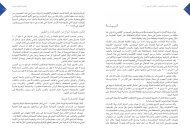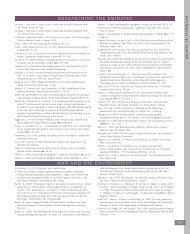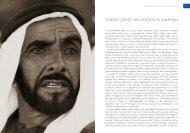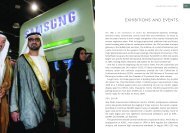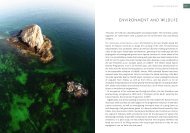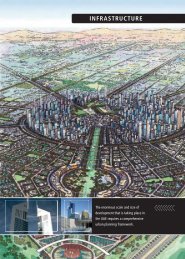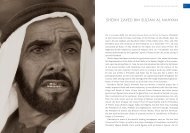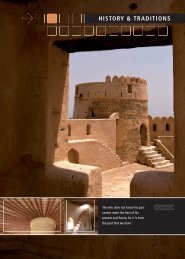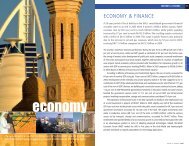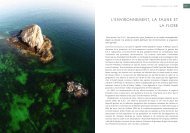You also want an ePaper? Increase the reach of your titles
YUMPU automatically turns print PDFs into web optimized ePapers that Google loves.
124UNITED ARAB EMIRATES YEARBOOK 2006<strong>ECONOMIC</strong> <strong>DEVELOPMENT</strong>125Six areas of maritime activity will be catered for: marine services, productmarketing, management, research and education, recreation, ship design andmanufacturing. Ship repair and maintenance services will also be headquarteredwithin the zone and marine management services ranging from cargo, vesseland life insurance agencies to legal businesses specialising in consultation, legaladvice and marine domain lawyers are also expected to set up offices.BunkeringThe <strong>UAE</strong> now ranks among the top locations in the world for bunkering. Fujairahhas overtaken Rotterdam to become the second-largest bunkering centre in theworld behind Singapore, which remains the world’s largest bunkering centre with acapacity of 19 million tonnes of fuel oil a year. Fujairah supplies 12 million tonnesof fuel oil a year, worth US$2.5 billion (Dh9.17 billion). This, in turn, has spawneda healthy growth in the ship supply business. Around 40 companies operate in thisfield in the Emirates as a whole, with an annual turnover of around US$300 million.OIL AND GASThe sharp rise in oil prices in 2004 brought to an end a decade of relativestability when prices mostly remained in the US$20 to US$28 per barrel range(with the exception of 1998 when a sharp downturn took place). The sudden pricejump was the result of an increase in demand rather than any disruption orrestriction in supplies. China is the most important contributor to the rise in worlddemand for oil. Its imports of crude oil almost doubled between 2002 and 2004.While each emirate takes responsibility for exploitation of its hydrocarbonreserves, with Abu Dhabi playing by far the largest role in this regard, the role ofthe Federal Government has been re-organised, with a new Ministry of Energycombining the former roles of the Ministry of Petroleum & Minerals and theMinistry of Electricity & Water. In January 2005 HH Sheikh Khalifa bin Zayed AlNahyan, President of the <strong>UAE</strong>, passed a law transferring the ownership of theshares and funds of National Petroleum Construction Company (NPCC) formAbu Dhabi National Oil Company (ADNOC) to the General Holding Corporation(GHC) in order to pave the way for its eventual privatisation and transformationinto a national joint stock company.Average 2004 prices were more than US$10 above the 2003 average (US$28.39in 2003 cf. US$38.87 in 2004). Oil prices continued to rise in 2005, with LowerZakum (39˚) exceeding US$57 per barrel in August. Year-to-date average at midyear(2005) was US$46.71 per barrel, with strong indications that the overallaverage price for 2005 would exceed that figure. In fact, global oil prices touchedUS$70 per barrel in September 2005. Oil revenues loosely tracked the price rises,depending also on production rates.With both price and production rates rising in 2004, revenues showed a markedincrease. A surge in world demand and requests to OPEC from the internationalcommunity to raise production levels resulted in the <strong>UAE</strong>’s production quota,allocated by OPEC, being adjusted five times during the year. Two reductions inthe first part of the year were followed by three increases, resulting in an averagequota, over the whole of 2004, of 2,189,000 barrels per day (b/d). In actual factit exceeded this level by 164,700 b/d.The <strong>UAE</strong> is capable of producing more oil than its OPEC quotas allow. Whilstit is true that reserves in Dubai and Sharjah have declined significantly, AbuDhabi, with 94.3 per cent of the <strong>UAE</strong>’s total oil and gas reserves, has significantadditional production capacity, which amounted to 500,000 b/d in 2004. This figureis being increased as a result of the huge investments that have been made in theindustry over the past five years. Abu Dhabi National Oil Company (ADNOC) hasinvested around US$10 billion on an expansion programme that plans to raiseproduction capacity to 3 million b/d in 2006 and 3.7 million b/d by 2010.OPEC’s five largest oil producers, the <strong>UAE</strong>, Saudi Arabia, Kuwait, Iraq and Iran,control more than 60 per cent of global oil reserves and produced 19.6 millionbarrels per day (mb/d) in 2004. The supply/demand balance for 2005, based onOPEC mid-year projections, indicated an expected average global oil demand of83.66 mb/d. With non-OPEC sources averaging 54.76 mb/d, this left OPEC tosupply the balance of 28.90 mb/d. As supplies from the <strong>UAE</strong> and other major OPECproducers stabilise at somewhat higher than the 2005 rate, supported by strongreserves, other sources are likely to become more seriously depleted. It is againstthis background that the <strong>UAE</strong> has committed to major developments in its oil andgas production and supply facilities.Notwithstanding major progress in its long-standing programme of diversificationaimed at reducing dependence on finite oil and gas resources, the <strong>UAE</strong>’s oil andgas sector continues to occupy prime status in the country’s economic profile –a fact bolstered by confirmed hydrocarbon reserves standing at 97.8 billion barrelsof oil and 213.5 trillion cubic feet of natural gas. Based on current knowledge,the <strong>UAE</strong>’s oil reserves, account for 9.6 per cent of the world’s total oil reserves,estimated at 1016.8 billion barrels (US Dept. of Energy, based on oil industryfigures). These figures rank the <strong>UAE</strong> in fifth place in terms of the size of its oilreserves (excluding Canadian oil-sands) and fourth with respect to its natural gasreserves. It has been suggested by oil experts that there could be approximatelydouble the presently discovered reserves in deeper layers, where drilling has, so far,not taken place. By far the greatest portion of the <strong>UAE</strong>’s oil reserves are locatedin Abu Dhabi Emirate with 92.2 billion barrels, followed by Dubai with 4 billionbarrels, Sharjah with 1.5 billion and Ra’s al-Khaimah with 100 million. Natural gasreserves are also concentrated in Abu Dhabi, which has 198.5 trillion cubic feet,



